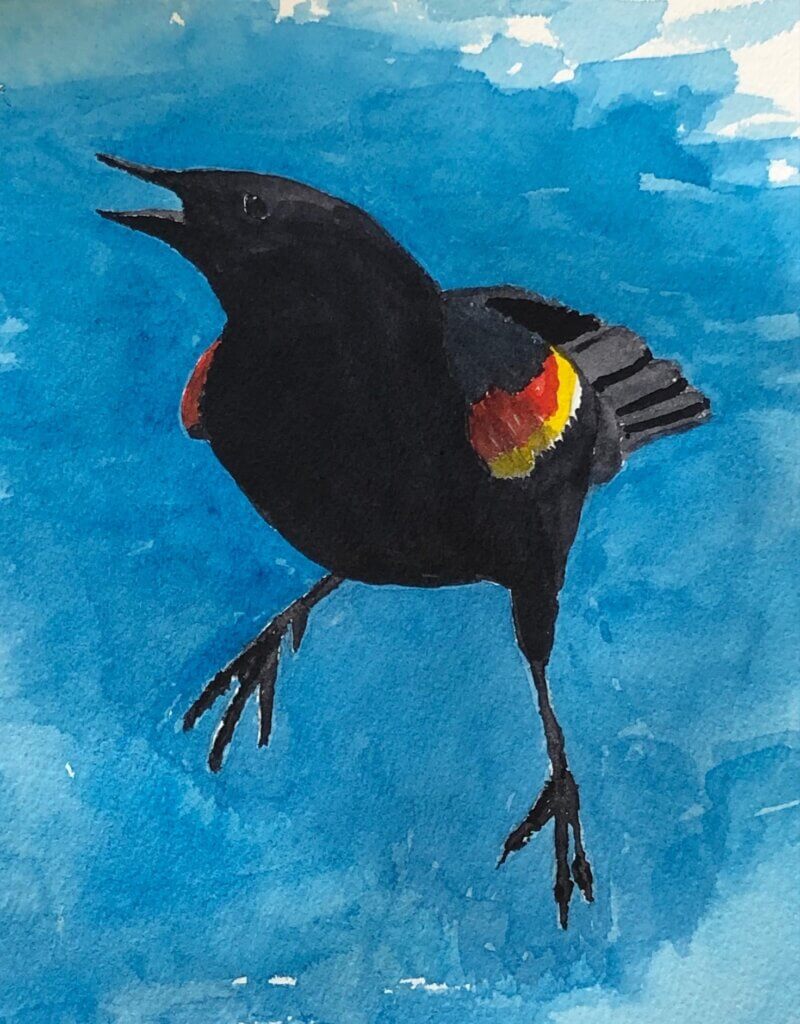Close Encounter with a Red-Winged Blackbird
by Mary Larson
Broadcast 4.6 & 4.6.2022

Red-winged Blackbird, watercolor painting © Mary Larson.
Listen:
I have the great good fortune to live along the banks of a boulder-cobbled river. From my fifth floor balcony vantage point, a flurry of springtime activity entertains me wherever I look. One afternoon while balcony-bird-watching, my attention was captured by a tiny black speck aggressively pursuing much larger birds, undeterred by the threat of sharp beaks and deadly talons. With equal measure, he intimidated crows, Osprey, eagles, vultures, and herons away from his territorial claim along the riverbank. With my binoculars and guidebook in hand, I identified him as a male Red-winged Blackbird after he flashed the telltale red and yellow striped epaulets on his shoulders, and loudly sang, “CONK-LA-REEEEE!” when he settled on a shoreline tree branch.
Upon further research I learned that the male of this species will fiercely defend a relatively large marshy habitat during breeding season, and will lure as many as a dozen females to join his harem there. In contrast to the male’s shiny dress uniform and bombastic behavior, quieter females are camouflaged in dull, streaky browns, harder to spot while nesting low along the reedy shoreline.
The next morning, I awoke to that same “CONK-LA-REEEE!” sounding significantly louder and closer than before. My new friend had expanded his territory to include my balcony! I watched from my living room, thrilled at the opportunity for extended observation of a wild creature at such proximity. Initially charmed, I became less so as he spent hours out there, pecking at the cushions, leaving droppings, and repeatedly uttering his noisy song, all the while apparently neglecting his true territory. I eventually surmised that he was angrily protecting his range from a perceived archnemesis – his own reflection in my window glass.
To defend against further furniture fouling, I covered the cushions with old, frayed towels, which this bird then took as an additional challenge, pecking at the terrycloth for hours. One particularly energetic wrestling match with the towel had him swinging in mid-air from the fabric corner like a pendulum, an upside-down skirmish, wings flapping all the while. Upon closer inspection, I realized this was no longer a battle, but an escape attempt – his left foot was wrapped in a twisted tangle of threads from the towel’s frayed corner.
At this point, I knew I had to intervene, lest he injure himself in his frenzy. With scissors in hand, I entered the balcony, with the idea that I could gently snip the threads that had entangled his foot. But that was not to be: his panic at my presence caused him to struggle that much harder, risking injury to his foot if I snipped too closely. Instead, I gently pulled the towel up toward me, accessing the corner that had entrapped his foot. His incessant flapping increased, and for the first time I heard the distress cry of the Red-winged Blackbird, a heart-wrenching “teeeeeew!” I managed to snip a half-inch from the corner of the towel; he immediately took off like a shot, the speck of blue towel still attached.
I wondered if I’d ever see him again; I wondered if he’d be able to remove that little towel fragment from his foot. I would not have long to wonder. He returned the very next day to take up his robust defense of the balcony, towel fragment nowhere in sight. I was initially relieved, but upon closer inspection, dismayed as I saw he was now missing a toe from his left foot. Still able to walk, but with a slight perceptible limp. I felt terrible about my role in the loss of his toe, and hoped he would be able to overcome that disability.
As the spring days lengthened and warmed, I began spending more and more time on the balcony, my presence shooing him away. Eventually he stopped visiting altogether, but I would still occasionally hear his distinctive “CONK-LA-REEEE!” from the other bank.
I hope to see him again around my river (but not my balcony) next spring!
Every week since 1991, Field Notes has inquired about Montana’s natural history. Field Notes are written by naturalists, students, and listeners about the puzzle-tree bark, eagle talons, woolly aphids, and giant puffballs of Western, Central and Southwestern Montana and aired weekly on Montana Public Radio.
Click here to read and listen to more Field Notes. Field Notes is available as a podcast! Subscribe on iTunes, Google Play, or wherever you listen to podcasts.
Interested in writing a Field Note? Contact Allison De Jong, Field Notes editor, at adejong [at] montananaturalist [dot] org or 406.327.0405.
Want to learn more about our programs as well as fun natural history facts and seasonal phenology? Sign up for our e-newsletter! You can also become a member and get discounts on our programs as well as free reciprocal admission to 300+ science centers in North America!












